Hawaiian Winter Storm
February 5th, 2025 by Jorel TorresIn the central Pacific Ocean last week, a strong low pressure system brought heavy rain and high winds to the Hawaiian islands. Snowfall accumulations were also observed on the summits of Mauna Kea and Mauna Loa that are located on the big island of Hawai’i. Additional media coverage of the winter storm can be viewed here and here.
GOES-18 ABI 10.3um imagery captured the center of the cyclone (i.e., initially found northwest of Hawaii) and its cold front travelling east, producing multiple rounds of precipitation over the islands.
GOES 18 ABI 10.3um IR observations from 21Z, 29 January 2025 to 00Z, 1 February 2025
The Advected Layer Precipitable Water (ALPW) product (animation shown below) provides a moisture perspective of the storm. Derived from multiple polar-orbiting satellites, ALPW highlights the precipitable water values of the cyclone in 4 atmospheric layers: surface-to-850mb (top-left), 850mb-700mb (top-right), 700-500mb (bottom-left), and 500-300mb (bottom-right). Within the black boxes in the animation, note the distinct storm circulation and the water vapor transport that aided in the development of heavy precipitation over the Hawaiian islands. Observe the moisture depth of the storm too, especially from the surface to 500-mb.
ALPW observations from ~01Z to 15Z, 31 January 2025
CoCoRaHS precipitation accumulations from the storm can be seen over Hawaii from 30 January to 1 February 2025. Per NOAA/NWS Record Event Reports, Honolulu, HI, set a new record of daily maximum rainfall of 3.57 inches on 30 January 2025. The new record broke the old record of 1.22 inches set back in 1975!

NOAA-20 VIIRS Day Cloud Phase Distinction RGB imagery highlights a before (29 January 2025) and after (2 February 2025) imagery comparison of the winter storm that passed through the big island of Hawai’i. The areal extent of the new snow cover is seen in green over the higher elevations of the island. The RGB imagery exhibits a 375-m spatial resolution.
Posted in: Uncategorized, | Comments closed
Hughes Fire, California
January 24th, 2025 by Jorel TorresFires have engulfed Southern California over the past few weeks, where another fire (i.e., the Hughes Fire) erupted just northwest of the Los Angeles metropolitan area. At the time of this blog entry (~22Z, 23 January 2025), the fire had scorched 10,000+ acres in Los Angeles and Ventura counties and was 24% contained. Dangerous fire conditions still persist through 24 January 2025, with red flag warnings that forecast low relative humidities and strong, gusty winds in southern California that could lead to significant fire growth or fire initiation. More coverage of the Hughes Fire can be viewed on CNN.
Geostationary satellites captured the fire initiation (~1833Z) along with the rapid growth of the Hughes Fire. Notice how the fire pixels flare up in northwestern Los Angeles County, where the fire spreads to the south and east within a ~4 hour time frame.
GOES – 18 ABI 3.9um from 1820Z-2200Z, 22 January 2025
Between 2000Z and 2140Z, three polar-orbiters observed the Hughes Fire at a higher spatial resolution of 375-m, compared to the coarser 2-km GOES ABI 3.9um. The higher spatial resolution provides finer details of the fire perimeter and the thermal hotspots (i.e., warmer brightness temperatures).
JPSS VIIRS 3.7um (I4 Band) at 2000Z, 2120Z and 2140Z on 22 January 2025
Another way to view the Hughes Fires is by the VIIRS Day Fire RGB which is sensitive to fire hotspots, smoke, along with vegetation health and burn scars. During the same time frame (i.e., 2000Z to 2140Z), this RGB observed the active fires and corresponding smoke plume that moves to the southwest. Note, the higher level clouds (i.e., located further south) shifting to the east. Like the VIIRS 3.7um, the VIIRS Day Fire RGB also exhibits a 375-m spatial resolution.
JPSS VIIRS Day Fire RGB at 2000Z, 2120Z and 2140Z on 22 January 2025
Posted in: Fire Weather, GOES, POES, Satellites, VIIRS, | Comments closed
New Orleans Snowstorm
January 22nd, 2025 by Jorel TorresA historic winter storm impacted the southern United States, blanketing several states with multiple inches of snow, spanning from southeast Texas (i.e., Houston metro area) to Florida and the Carolinas. Numerous flights were delayed or cancelled at the Louis Armstrong New Orleans International Airport from 21-22 January 2025, where the airport accumulated 8 inches from the storm. Additional unofficial snow reports across the New Orleans metro area, that also includes neighboring parishes and counties can be accessed via National Weather Service (NWS). Photos and videos of the snowstorm in New Orleans were collected and depicted by Axios. The Weather Channel has the latest updates covering the winter storm and its impacts.
The fresh snowpack was captured by the VIIRS instrument on-board JPSS polar-orbiting satellites. The NOAA-21 VIIRS GeoColor product observed the snow cover over southern Louisiana and Mississippi at 750-m spatial resolution. Notice the sharp gradient of snow cover (seen in white) located south of Alexandria, LA, exhibiting a southwest-to-northeast orientation. Widespread snow cover can be seen near or along the coastline as well.
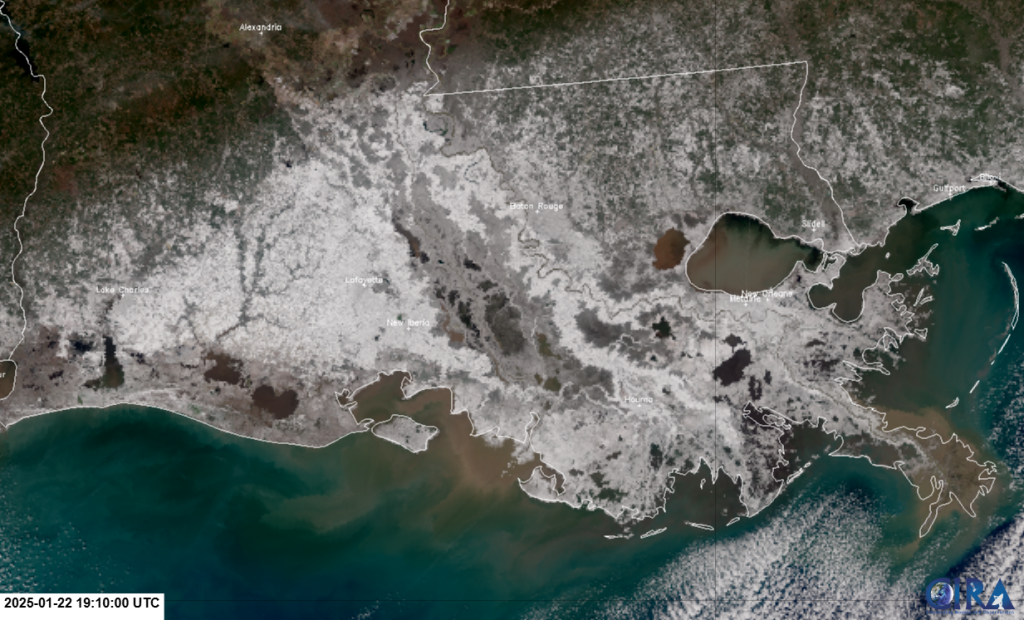
Zooming out over the southern U.S., the snow cover can be seen by multiple overpasses from the SNPP, NOAA-20, and NOAA-21 VIIRS Day Cloud Phase Distinction RGB on 22 January 2025. From this RGB, the snow cover is seen in green, extending from southeast Texas to the Carolinas. The snow cover observations seen by the imagery, express similar agreement with the CoCoRaHS 24-hour snowfall reports observed over the same domain.
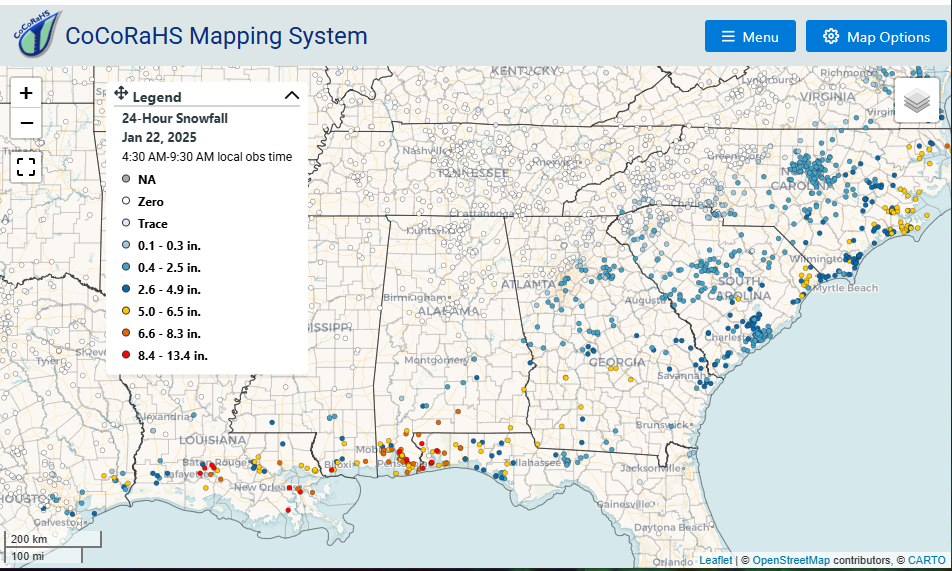
Posted in: POES, Satellites, VIIRS, Winter Weather, | Comments closed
Mountain Fire, California
November 8th, 2024 by Jorel TorresOn the morning of 6 November 2024, the Mountain Fire erupted, and fueled by strong winds, the fire spread southwestward towards cities located along the California coastline. The GOES-18 GeoColor product (see below) observed the fire and the corresponding smoke plumes from ~18-21Z, 6 November 2024. The narrow, long, smoke plumes advected westward offshore and eventually inundated the neighboring Anacapa, Santa Cruz and Santa Rosa islands.
Over the same time period, the GOES-18 Fire Temperature RGB provided a qualitative estimate of the fire intensities of the Mountain Fire. The RGB depicts fire pixels as red, orange, yellow and white colors. The red colors exhibit “warm fires”, orange colors as “very warm fires”, yellow colors as “hot fires” and white colors as “very intense fires”. Notice the rapid change in fire intensities and the fire spread towards the coastline.
At approximately 20:43Z, 6 November 2024, the VIIRS instrument on-board the NOAA-20 satellite captured the Mountain Fire at a high spatial resolution of 375-m. The VIIRS Day Fire RGB (bottom-left) depicts the active fires (red colors) and the smoke seen in blue over Oxnard, CA (and offshore) while the quantitative VIIRS Active Fires product (bottom-right) shows the fire intensity (i.e., Fire Radiative Power, FRP) values expressed in MegaWatts (MW). Note, the VIIRS Active Fires product exhibits yellow to dark red fire pixels that indicate increasing fire intensity values, where yellow pixels indicate “cooler fires” and dark red pixels as the “most intense fires”.
VIIRS Day Fire RGB (a.k.a., Day Land Cloud Fire RGB) and the VIIRS Active Fires product
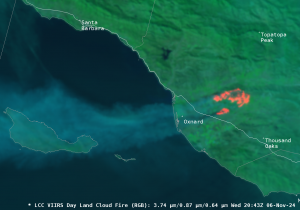
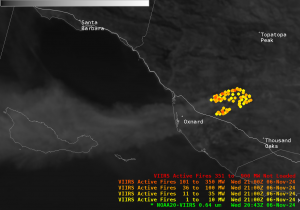
Given a closer look at the fire intensity values, forecasters can utilize the sample function in AWIPS, where the cursor readout values show several characteristics of the fire pixels: the time stamp, the polar-orbiting satellite, the fire confidence intervals (i.e., low, nominal or high), and the FRP values expressed in MW.
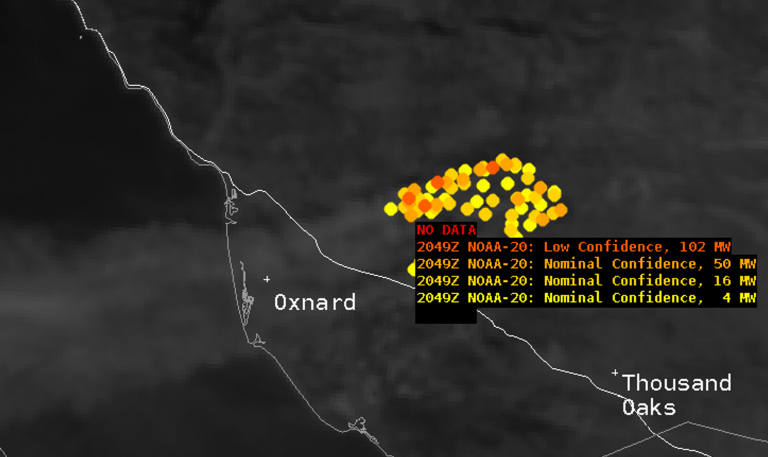
As of 8 November 2024, the Mountain Fire burned 20,000+ acres that included dozens of structures, and led to mass evacuations of homes, schools and businesses. The fire is 7% contained. To further monitor the Mountain Fire, users can refer to the CalFire webpage.
Posted in: AWIPS, Fire Weather, GOES, POES, Satellites, VIIRS, | Comments closed
Park Fire, California
August 7th, 2024 by Jorel TorresThe Park Fire in California initiated two weeks ago and portions of the fire perimeter are still ablaze at the time of this blog entry. As of 7 August 2024, the Park Fire has burned 420,000 plus acres and is only 34% percent contained (per InciWeb). The JPSS SNPP VIIRS Day Fire RGB and the VIIRS Fire Temperature RGB imagery observed the Park Fire on 6 August 2024 at 20:40Z.
The Day Fire RGB shows the extensive burn scar (reddish brown colors) produced by the Park Fire, along with active fire hotspots (seen in red colors) and the corresponding smoke plume (blue-grey colors). The VIIRS Fire Temperature RGB can also be employed for fire detection and provides a qualitative estimate of fire intensity. In the Fire Temperature RGB imagery, red pixels indicate ‘warm’ fires, orange pixels are designated as ‘very warm’ fires, yellow pixels are ‘hot’ fires, and white pixels are ‘very intense’ fires. On the northeast periphery of the Park Fire, a mix of yellow and white pixels can be seen, indicating that hot and very intense fires are present. The VIIRS Day Fire RGB is at a 375-m spatial resolution, while the VIIRS Fire Temperature RGB is at 750-m.

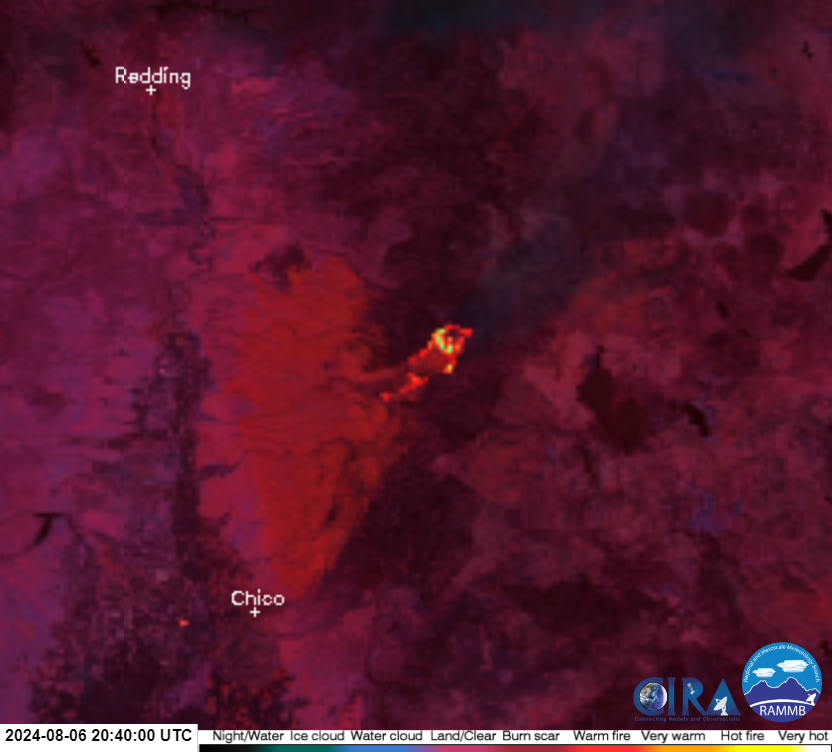
A daytime VIIRS Day Fire RGB animation of the rapid fire spread, smoke, active fires and burn scar can be seen below. The daytime animation spans two weeks, from 24 July 2024 to 5 August 2024.
Posted in: Fire Weather, POES, Satellites, VIIRS, | Comments closed
